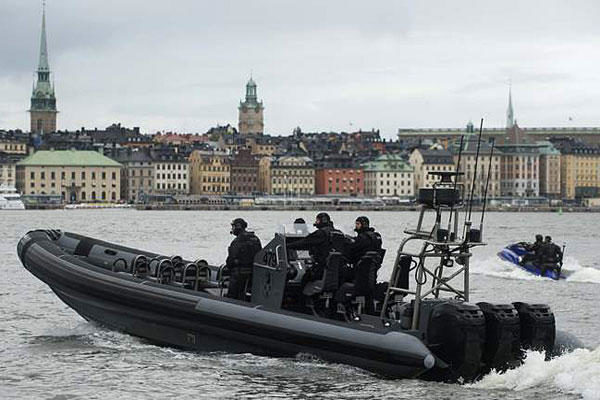
Sweden increased military spending after the scare
The alarm was raised when encrypted transmissions sent on an emergency radio frequency used by Russian units were recorded. The sources of the transmissions were identified as a submarine and a military site in the Kaliningrad region.
Reported sightings of the unidentified submarine started to emerge amid rumours that the Russian oil tanker Concord, which was criss-crossing outside Stockhom, was acting as a mother-ship for smaller underwater vessels.
Several days later, the hunt was still on and officials became certain foreign underwater operations were underway.
More than 100 sightings by members of the public were logged as the chase intensified.
But
no Russian sub, or any concrete evidence that such a vessel had been anywhere near Stockhom, was ever found and questions about the costly hunt were soon being raised.
In April 2015, Rear Admiral Anders Grenstad told Swedish newspapers a report to the Swedish government revealed at least one of the sightings of a suspected underwater vessel was in fact a civilian "working boat".
What Sweden's former Supreme Commander Sverker Göransson initially described as a "confirmed violation of Swedish waters by a small submarine" turned out to be preliminary data which was later proved to be erroneous.
A military source told Svenska Dagbladet: "When conducting an underwater investigation, and the task is to confirm or reject a unique sound recording, it is a pervasive process.
"It usually takes a long time to get it in place. Then, however, things went very fast. The analyses were not completed.
"The criteria for a confirmed submarine are rock hard, and they were not fulfilled."
A 100-page final report into the incident took months to complete and in that time new defence budgets were signed off by the centre-left government in the meantime.
According to investigative journalist Jonas Gummesson, the reason for the level of certainty was political with
defence chiefs under pressure to deliver a result from the submarine chase.Insiders said: "There were proposals from the government and certain parts of the headquarters."
Mattias Göransson, the author of the book "The Bear Comes", which details previously suspected submarine violations that in hindsight proved to be something else, such as minke whales or shoals of fish, described the 2014 submarine chase as a "political meltdown".
He said the
Swedish media had "about ten thousand chances" to learn to be more critical of claims of foreign powers' submarines in Swedish waters.He said: "Over the past 40 years, about the same number of underwater intrusions were reported by the population. Despite this, the Navy has failed to present a single bit of sustainable proof of a single conscious Russian submarine infringement."And although the real story behind he submarine hunt of 2014 was never fully established,
it saw opinion polls swing towards NATO membership for Sweden and kick-started the first of several boosts to defence spending.
For the first time in more than two decades, the Swedish government embarked on a sustained expansion of the defence budget, pledging to increase spending from £3.5bn in 2016 to £4.10bn in 2020.
Comment: See also:
- US media loses it when Russian 'spy' ship makes annual trip to the Caribbean
- 'Russia hacked the birds': Social media users mock Swedish paranoia after birds take down fighter jet
- Russian Su-27 fighter jet intercepts US spy plane over Baltic Sea
And check out SOTT radio's: The Truth Perspective: The Strange Contagion: How Viral Thoughts and Emotions Secretly Control Us